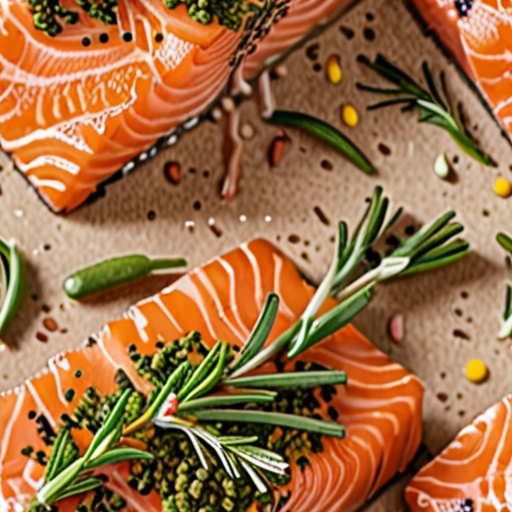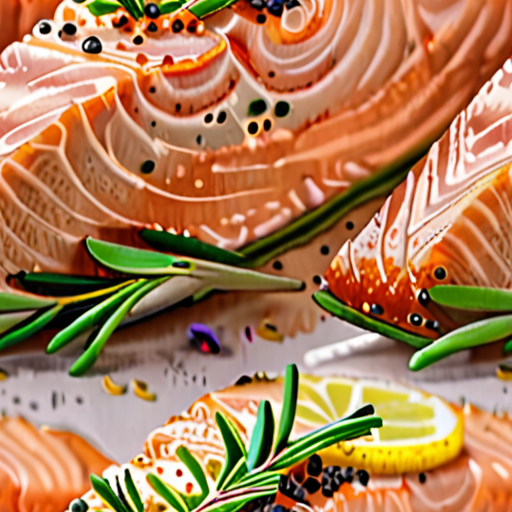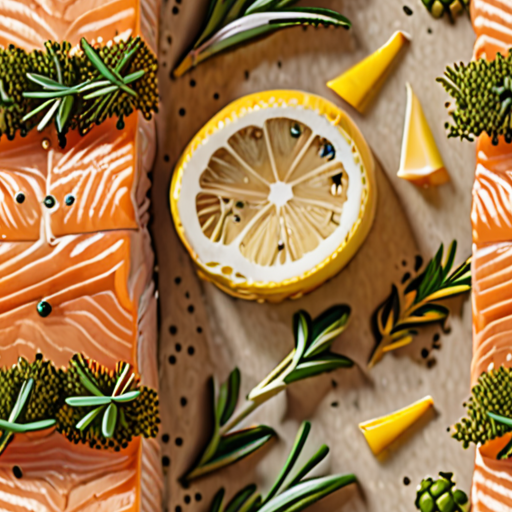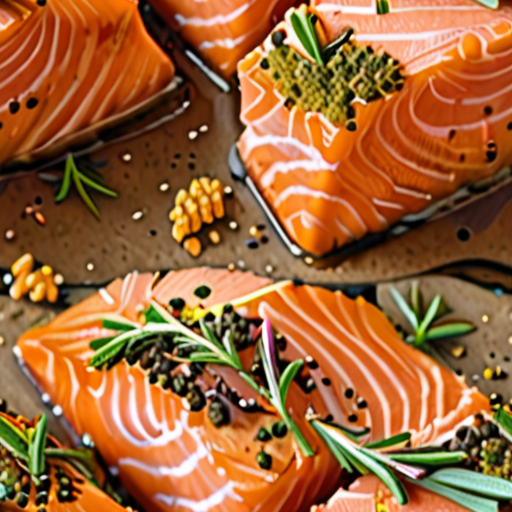When it comes to elevating your menu with a dish that’s both flavorful and visually appealing, few options stand out like herb-crusted salmon. This culinary delight has captured the hearts of foodies and chefs alike, and for good reason – the combination of succulent salmon, fragrant herbs, and a crispy crust is a match made in heaven. But what makes herb-crusted salmon truly special? And how can you incorporate this mouthwatering dish into your repertoire? From exploring popular herbs to pairing thyme with lemon and garlic, we’ll delve into the world of herb-crusted salmon and uncover the secrets to creating a truly unforgettable dining experience.

Best Herbs to Pair with Salmon
When it comes to pairing herbs with salmon, there are several options to consider.
- Dill: A classic combination, dill and salmon are a match made in heaven. The bright, citrusy flavor of dill complements the rich flavor of salmon perfectly.
- Parsley: Parsley adds a fresh, green flavor to salmon that pairs well with a variety of seasonings and sauces.
- Tarragon: Tarragon has a slightly sweet, anise-like flavor that pairs well with the richness of salmon.
- Thyme: Thyme adds a savory, earthy flavor to salmon that pairs well with Mediterranean-inspired seasonings and sauces.
- Basil: Basil adds a bright, summery flavor to salmon that pairs well with light, refreshing seasonings and sauces.
These herbs can be used in a variety of ways, from adding them to marinades and sauces to sprinkling them on top of the fish before baking or grilling.
Some popular ways to prepare salmon with herbs include:
- Grilled Salmon with Dill and Lemon: Marinate salmon fillets in a mixture of olive oil, lemon juice, garlic, and chopped fresh dill, then grill until cooked through.
- Baked Salmon with Parsley and Capers: Mix chopped parsley and capers into a sauce made with olive oil, lemon juice, and garlic, then brush it over baked salmon fillets.
- Pan-Seared Salmon with Tarragon and Browned Butter: Sear salmon fillets in a hot skillet until browned on both sides, then finish with a pat of browned butter infused with chopped tarragon.
- Smoked Salmon with Thyme and Cream Cheese: Mix softened cream cheese with chopped thyme and smoked salmon, then spread on crackers or toast points.
- Salmon Salad with Basil and Feta: Mix diced cooked salmon with chopped basil, crumbled feta cheese, and a squeeze of lemon juice, served on top of a bed of greens.
Experiment with different combinations of herbs and seasonings to find your favorite way to enjoy salmon!
Getting a Good Crust on Salmon
To achieve a perfect crust on salmon, it’s essential to understand the factors that contribute to its formation.
- Temperature Control: Preheat your oven to 400°F (200°C). A hot oven ensures a crispy exterior, while a lower temperature can result in a soft crust.
- Pat Dry the Salmon: Pat the salmon dry with paper towels before seasoning to remove excess moisture, which helps the crust form evenly.
- Seasoning: Sprinkle both sides of the salmon with salt, pepper, and any other seasonings you prefer. Let it sit for 10-15 minutes to allow the flavors to penetrate the meat.
- Oil Brushing: Lightly brush the salmon with oil to prevent drying out during cooking and promote browning.
- Cooking Time: Cook the salmon for 12-15 minutes per pound, depending on the thickness and your desired level of doneness.
- Finishing Touches: Remove the salmon from the oven and let it rest for 5 minutes before serving. This allows the juices to redistribute, making the fish easier to slice and more tender to eat.
By mastering these techniques, you’ll be able to achieve a delicious, golden-brown crust on your salmon every time.
Tips for Achieving a Perfect Crust
- Don’t Overcrowd the Pan: Cooking too many fillets at once can lead to steaming instead of searing, resulting in a soft crust.
- Use a Cast-Iron Skillet: These pans retain heat well and can achieve a nice crust on the bottom of the salmon.
- Don’t Press Down on the Fish: Resist the temptation to press down on the salmon with your spatula, as this can push out juices and prevent the crust from forming.
Common Mistakes to Avoid
- Overcooking: Salmon can quickly become dry and tough if cooked for too long.
- Insufficient Seasoning: Failing to season the salmon adequately can result in a bland flavor profile.

What Does Gordon Ramsay Put On His Salmon?
Gordon Ramsay’s salmon recipe is a masterclass in simplicity and flavor, showcasing the perfect balance between delicate fish and bold seasonings.
- Caramelize lemons by slicing them thinly and cooking them in a pan with a small amount of sugar until golden brown
- Tuck the caramelized lemon slices around the fish, placing some in the cavity and some on top
- Sprinkle star anise and peppercorns over and around the fish, adding some inside the cavity for extra depth of flavor
- Drizzle the salmon with a little olive oil to enhance its natural flavors
When preparing my own salmon dishes, I often draw inspiration from Gordon Ramsay’s techniques and ingredients. By incorporating these simple yet effective methods into my cooking routine, I can elevate my seafood creations to new heights.
For those looking to try out Gordon Ramsay’s salmon recipe, I recommend starting with high-quality ingredients and paying close attention to the cooking process. By doing so, you’ll be able to recreate this mouth-watering dish in the comfort of your own kitchen.
As a seafood enthusiast, I appreciate the importance of using fresh and sustainable ingredients in our cooking. At Only Fish Recipes , we’re committed to sharing delicious and easy-to-follow recipes that showcase the best of the ocean’s bounty.
Whether you’re a seasoned chef or just starting out, I encourage you to experiment with different seasoning combinations and cooking techniques to find your own unique take on Gordon Ramsay’s salmon recipe.
By combining classic flavors with modern twists, you can create truly unforgettable seafood dishes that will leave your friends and family begging for more.

What Seasoning Goes Well with Salmon?
When it comes to seasoning salmon, there are several options to consider.
- Lemon pepper: A classic combination that pairs well with the delicate flavor of salmon.
- Dill: Fresh dill adds a bright, citrusy flavor that complements the richness of salmon.
- Paprika: Smoked or sweet paprika can add a smoky depth to salmon, making it perfect for grilled or pan-seared dishes.
- Cajun seasoning: A blend of spices that includes paprika, garlic powder, onion powder, and cayenne pepper, Cajun seasoning adds a bold, spicy flavor to salmon.
- Herbs de Provence: A French herb blend that typically includes thyme, rosemary, oregano, and lavender, Herbs de Provence adds a complex, aromatic flavor to salmon.
These seasonings can be used individually or in combination to create unique flavor profiles for your salmon dishes.
Tips for Seasoning Salmon:
- Let the salmon sit at room temperature for 30 minutes before seasoning to allow the flavors to penetrate deeper into the meat.
- Use a light hand when applying seasonings, as too much can overpower the delicate flavor of the salmon.
- Experiment with different combinations of seasonings to find the perfect balance of flavors for your taste buds.
Popular Salmon Recipes:
- Salmon Lemon Pepper Recipe
- Dill Salmon Recipe
- Grilled Salmon with Paprika Recipe
Should I Oil Salmon Before Seasoning?
To get the most out of your grilled salmon, it’s essential to prepare it correctly.
- Gently pat the fish dry with a paper towel to remove excess moisture.
- Brush the salmon with a small amount of oil to prevent sticking and promote even browning.
- Sprinkle salt and pepper on all sides of the fish, including the skin, to enhance flavor.
When choosing an oil for grilling, consider using a neutral-tasting oil like canola or grapeseed.
These oils have a high smoke point, which means they won’t burn or smoke easily when exposed to high heat.
Additionally, they won’t overpower the delicate flavor of the salmon.
For a more flavorful option, try using avocado oil or olive oil, which have a mild nutty taste that complements the richness of the fish.
Remember to apply the oil lightly, as too much oil can make the salmon greasy and difficult to cook evenly.
By following these simple steps, you’ll be able to achieve a perfectly seasoned and cooked piece of salmon every time.

What Season Is Best to Salmon Fish?
The peak season for salmon fishing typically occurs from May through September, with the five major species spread across the season.
-
King Salmon Fishing
Kings are known for their aggressive behavior and strong fighting ability, making them a popular target among anglers. They begin running in May and can be found in rivers and streams throughout Alaska.
-
Silver Salmon Fishing
Silvers are another popular species among anglers, prized for their flavorful meat and acrobatic leaps during the fight. They run from July through October, with the peak months being August and September.
-
Coho Salmon Fishing
Cohos are a staple of Alaskan fisheries, with a long-running season that spans from June through October. They’re known for their impressive size and strength, making them a thrilling catch for experienced anglers.
-
Pink Salmon Fishing
Pinks are the most abundant species in Alaskan waters, with a short but intense season that peaks in July and August. They’re a great choice for beginners due to their smaller size and relatively calm behavior.
-
Sockeye Salmon Fishing
Sockeyes are highly prized for their rich flavor and firm texture, making them a favorite among chefs and foodies. Their season runs from June through September, with the peak months being July and August.
When planning your salmon fishing trip, consider the specific species you’re targeting and the time of year they’re most active. By doing so, you’ll increase your chances of landing a trophy-sized catch and enjoying a memorable experience on the water.
Conclusion:
In conclusion, the best season to salmon fish depends on the specific species you’re targeting and the location you plan to fish. By understanding the peak seasons and behaviors of each species, you’ll be well-equipped to plan a successful and enjoyable fishing trip in Alaska.

0 Comments